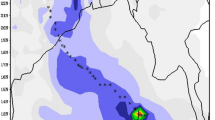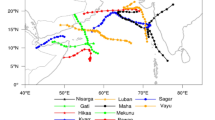Abstract
India Meteorological Department (IMD) introduced the objective tropical cyclone (TC) track forecast valid for next 24 hrs over the North Indian Ocean (NIO) in 2003. It further extended the validity period up to 72 hrs in 2009. Here an attempt is made to evaluate the TC landfall forecast issued by IMD during 2003–2013 (11 years) by calculating the landfall point forecast error (LPE) and landfall time forecast error (LTE).
The average LPE is about 67, 95, and 124 km and LTE is about 4, 7, and 2 hrs, respectively for 24, 48, and 72-hr forecasts over the NIO as a whole during 2009–2013. The accuracy of TC landfall forecast has been analysed with respect to basin of formation (Bay of Bengal, Arabian Sea, and NIO as a whole), specific regions of landfall, season of formation (pre-monsoon and post-monsoon seasons), intensity of TCs (cyclonic storm (CS), and severe cyclonic storm (SCS) or higher intensities) at the time of initiation of forecast and type of track of TCs (climatological/straight moving and recurving/looping type). The LPE is less over the BOB than over the AS for all forecast lengths up to 72 hrs. Similarly, the LPE is less during the post-monsoon season than during pre-monsoon season. The LPEs are less for climatologically moving/straight moving TCs than for the recurving/looping TCs.
The LPE over the NIO has decreased at the rate of about 14.5 km/year during 2003–2013 for 24-hr forecasts. The LTE does not show any significant improvement for 24-hr forecast during the same period. There is significant decrease in LPE and LTE during 2009–2013 compared to 2003–2008 due to the modernisation programme of IMD. The 24-hr LPE and LTE have decreased from 157.5 to 66.5 km and 7.8 to 4.1 hrs, respectively. However, there is still scope for further reduction in 48 and 72-hr forecast errors over the NIO to about 50 and 100 km respectively based on the latest technology including aircraft reconnaissance, deployment of buoys, and assimilation of more observational data from satellite and Doppler weather radars, etc., in the numerical weather prediction (NWP) models during the next five years.









Similar content being viewed by others
References
Fraedrich K and Leslie M 1989 Estimates of cyclone track predictability. I: Tropical cyclones in the Australian region; Quart. J. Roy. Meteor. Soc. 115 79–92.
IMD 2003 Cyclone Manual; IMD, New Delhi.
IMD 2008 Track of storm and depressions over the Indian seas during 1891–2007, ‘Cyclone e-Atlas of IMD’; IMD, Chennai.
IMD 2013 Cyclone Warning in India: Standard Operation Procedure; IMD, New Delhi.
Mohanty U C, Osuri Krishna K, Routray A, Mohapatra M and Pattanayak Sujata 2010 Simulation of Bay of Bengal Tropical Cyclones with WRF Model: Impact of initial and boundary condition; Marine Geodesy 33 294–314.
Mohapatra M, Mandal G S, Bandyopadhyay B K, Tyagi A and Mohanty U C 2012a Classification of cyclone hazard prone districts of India; Natural Hazards 63 (3) 1601–1620.
Mohapatra M, Bandyopadhyay B K and Tyagi Ajit 2012b Best track parameters of tropical cyclones over the North Indian Ocean: A review; Natural Hazards 63 1285–1317. doi: 10.1007/s11069-011-9935-0.
Mohapatra M, Nayak D P and Bandyopadhyay B K 2012c Evaluation of cone of uncertainty in tropical cyclone track forecast over North Indian Ocean issued by India Meteorological Department; Tropical Cyclone Research and Review 1 331–339.
Mohapatra M, Nayak D P, Sharma R P and Bandyopadhyay B K 2013a Evaluation of official tropical cyclone track forecast over North Indian Ocean issued by India Meteorological Department; J. Earth Syst. Sci. 122 589–601.
Mohapatra M, Sikka D R, Bandyopadhyay B K and Tyagi A 2013b Outcomes and challenges of forecast demonstration project (FDP) on landfalling cyclones over the Bay of Bengal; Mausam 64 1–12.
NHC USA 2012 Forecast verification report, National Oceanic and Atmospheric Administration, http://www.nhc.noaa.gov/verification.
Neumann C J and Pelissier J M 1981 An analysis of Atlantic tropical cyclone forecast errors, 1970–1979; Mon. Wea. Rev. 109 1248–1265.
Osuri Krishna K, Mohanty U C, Routray A and Mohapatra M 2011 The impact of satellite-derived wind data assimilation on track, intensity and structure of tropical cyclones over the North Indian Ocean; Int. J. Remote Sens., doi: 10.1080/01431161.2011.596849.
Osuri Krishna, Mohanty U C, Routray A and Mohapatra M 2012 Real-time Track Prediction of Tropical Cyclones over the North Indian Ocean using the ARW model; J. Appl. Meteorol. Climatol., doi: 10.1175/JAMC-D-12-0313.1.
Plu M. 2011 A new assessment of the predictability of tropical cyclone tracks; Mon. Wea. Rev. 139 3600–3608.
Powell M D and Aberson S D 2001 Accuracy of United States tropical cyclone landfall forecasts in the Atlantic basin (1976–2000); Bull. Am. Meteor. Soc. 82 2749–2767.
Rao Y P 1976 Southwest Monsoon, Met Monograph, IMD, No. 1/1976, 335p.
RSMC New Delhi 2010 Report on Cyclonic Disturbances Over The North Indian Ocean During 2009; IMD, New Delhi.
RSMC New Delhi 2013 Report on Cyclonic Disturbances Over The North Indian Ocean During 2012; IMD, New Delhi.
RSMC Tokyo 2011 Annual Report on activities of the RSMC Tokyo Typhoon Center; http://www.jma.go.jp/rsmc-hp-pub-eg/annualreport.html.
Simpson R H 1971 The decision process in hurricane forecasting; NOAA Tech Memo NWS SR-53, 33p.
Acknowledgements
The authors are thankful to Director General of Meteorology, IMD for his support and encouragement to carry out this work. They are also thankful to Cyclone Warning Division for collection of data required for this work. They also thank the anonymous reviewers for their comments for improvement of the paper.
Author information
Authors and Affiliations
Corresponding author
Rights and permissions
About this article
Cite this article
Mohapatra, M., Nayak, D.P., Sharma, M. et al. Evaluation of official tropical cyclone landfall forecast issued by India Meteorological Department. J Earth Syst Sci 124, 861–874 (2015). https://doi.org/10.1007/s12040-015-0581-x
Received:
Revised:
Accepted:
Published:
Issue Date:
DOI: https://doi.org/10.1007/s12040-015-0581-x




